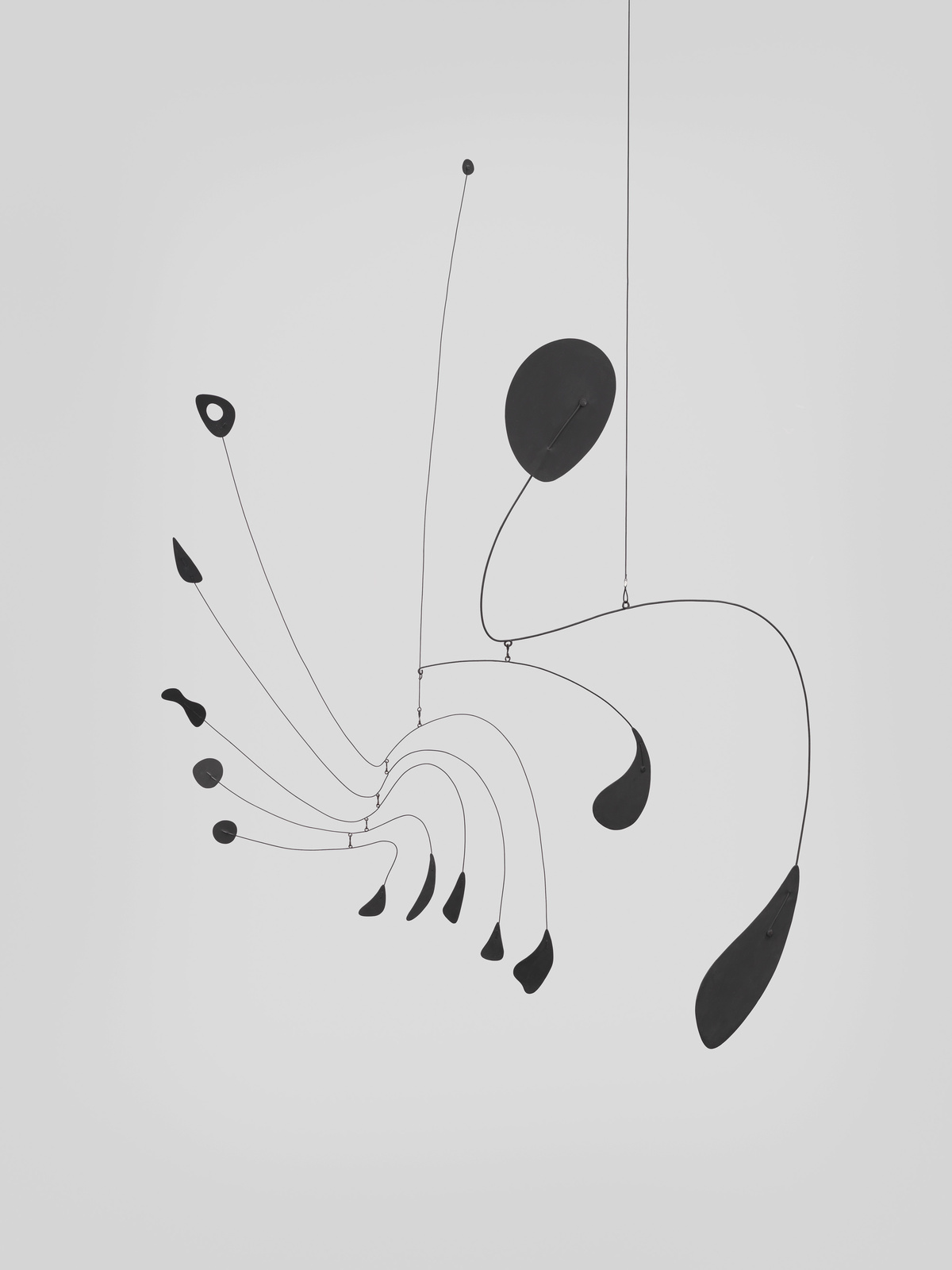Not on view
Date
c. 1940
Classification
Sculpture
Medium
Painted sheet metal and wire
Dimensions
Overall: 49 1/2 × 35 1/2in. (125.7 × 90.2 cm)
Accession number
84.41
Credit line
Whitney Museum of American Art, New York; Mrs. John B. Putnam Bequest
Rights and reproductions
© Calder Foundation, New York / Artists Rights Society (ARS), New York
Audio
-
0:00
Alexander Calder, Hanging Spider, c. 1940
0:00
Narrator: Alexander Calder called this sculpture Hanging Spider. It doesn’t represent a spider in any straightforward way—for one thing, it seems to have more than eight legs. But as it moves with the breeze, it suggests a kind of spindly daddy longlegs elegance. In the 1930s, Calder had absorbed the Surrealists’ love of biomorphic forms—shapes that suggested life, but were still somewhat abstract. He also picked up on their idea that accident had a role to play in art. This sculpture, with its almost-natural movements and subjugation to the vagaries of air currents, reflects both interests.
Calder invented this form of kinetic sculpture in 1932. He began calling such works mobiles—French for “moving”—at the suggestion of the artist Marcel Duchamp.
-
0:00
Alexander Calder, Hanging Spider, 1940
0:00
Narrator: Alexander Calder called this hanging sculpture Spider. It doesn’t represent a spider in any straightforward way—for one thing, it seems to have more than eight legs. But as it moves with the breeze, it suggests a kind of spindly, daddy longlegs elegance. In the 1930s, Calder had absorbed the Surrealists’ love of biomorphic forms—shapes that suggested life, but were still somewhat abstract. He also picked up on their idea that accident had a role to play in art. This sculpture, with its almost-natural movements and subjugation to the vagaries of air currents, reflects both interests.
Calder invented this form of kinetic sculpture in 1932. He began calling such works mobiles—French for “moving”—at the suggestion of the artist Marcel Duchamp.
Exhibitions
-
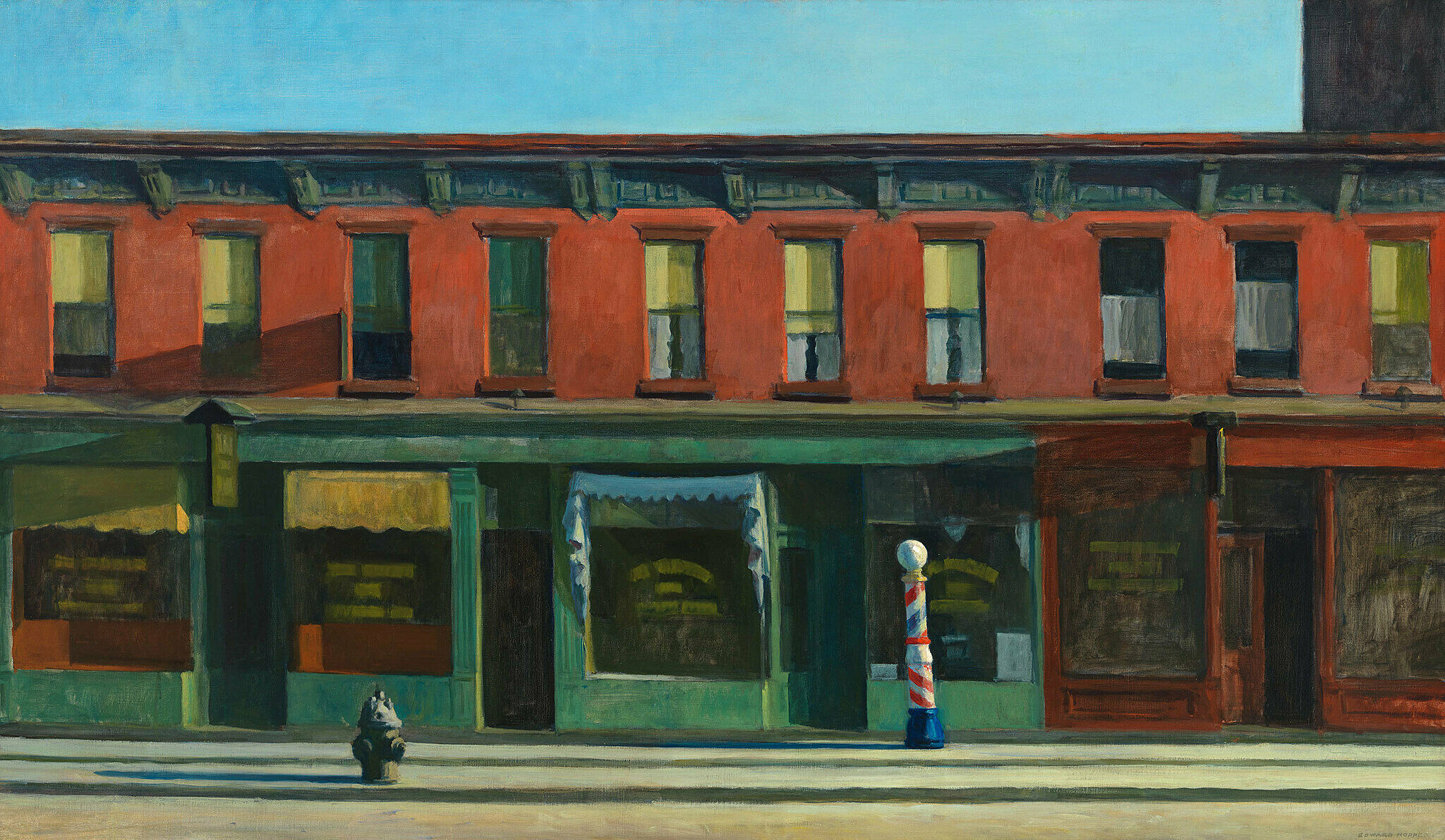
The Whitney’s Collection: Selections from 1900 to 1965
June 28, 2019–May 1, 2025
-
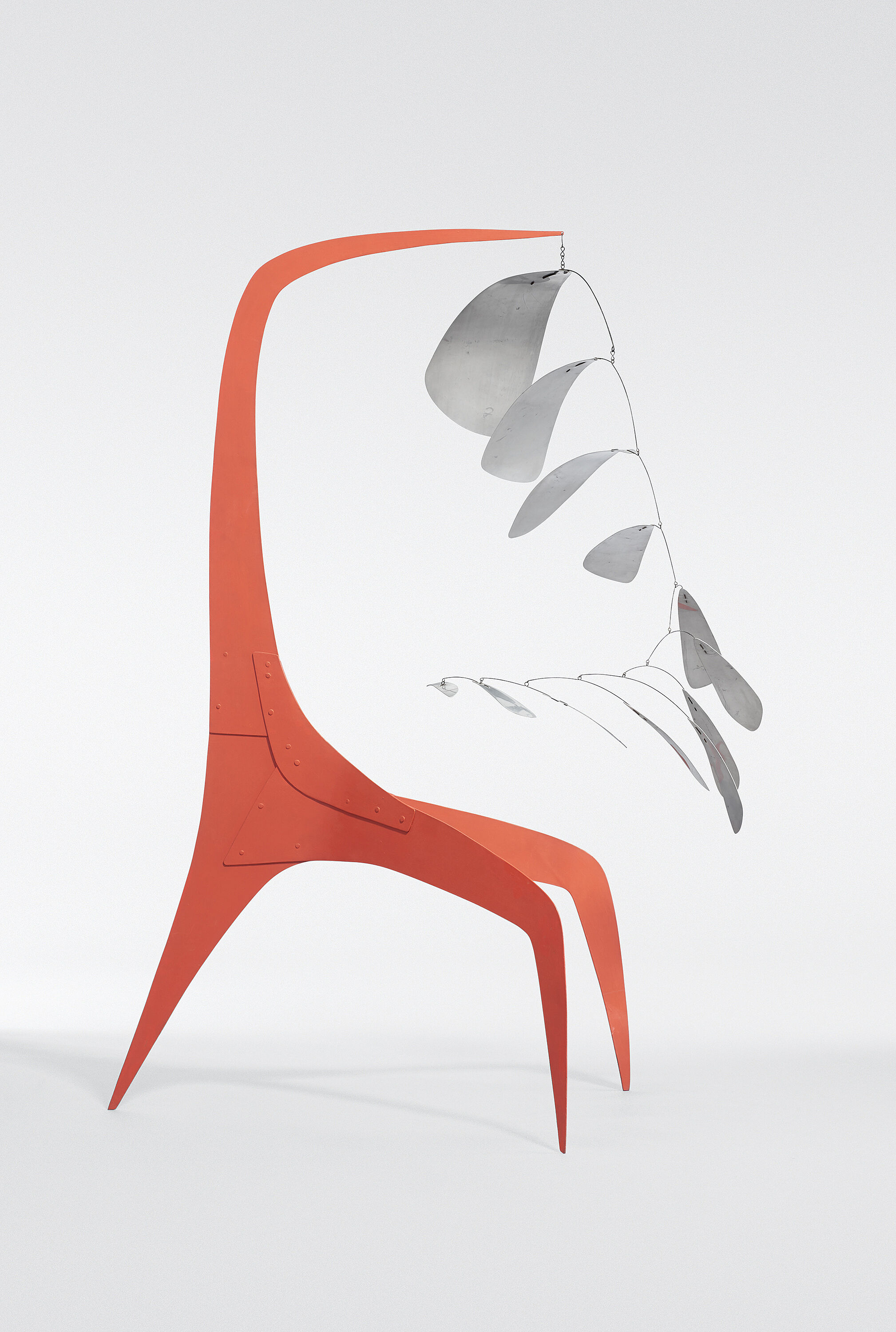
Calder: Hypermobility
June 9–Oct 23, 2017
-
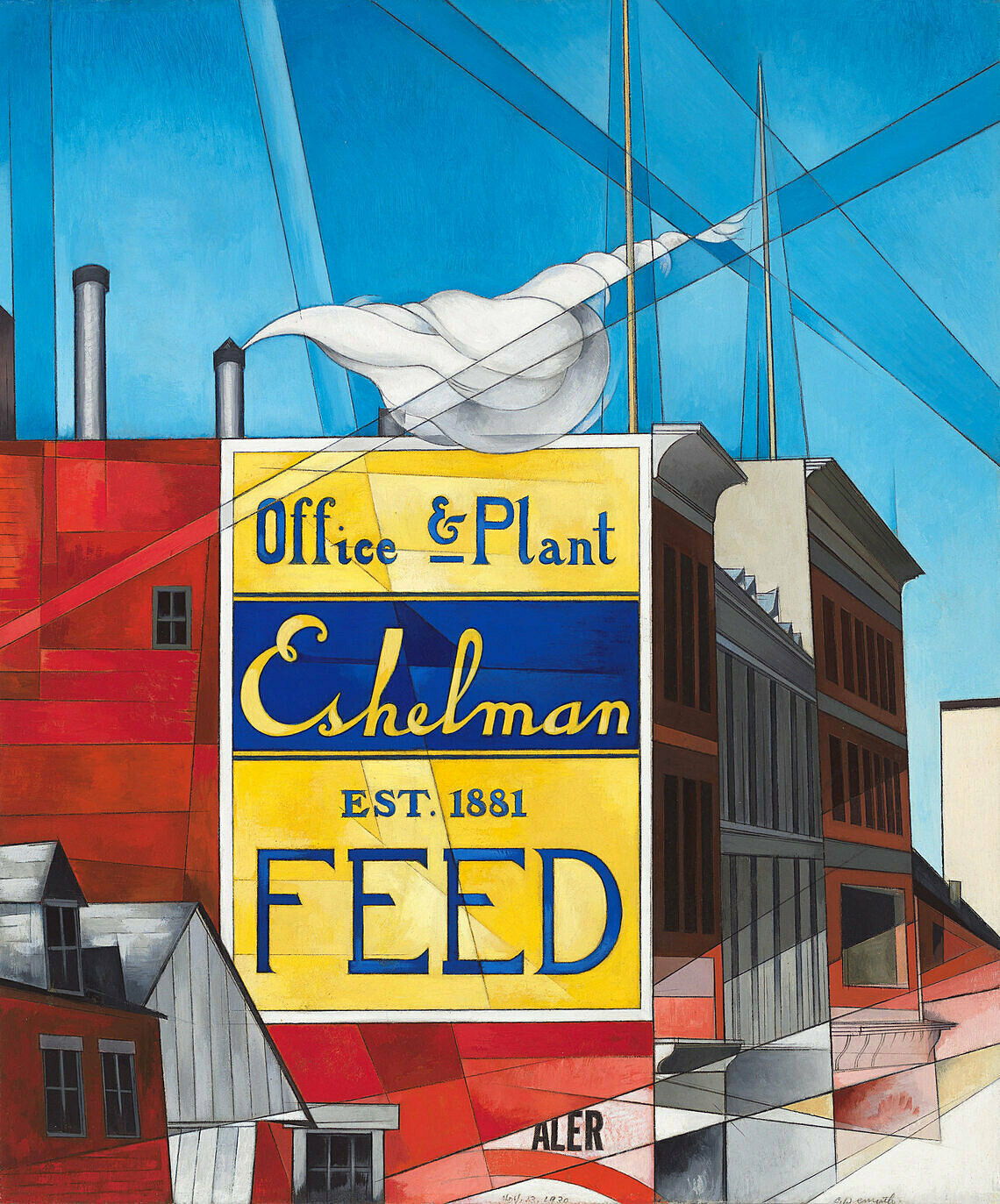
Where We Are: Selections from the Whitney’s Collection, 1900–1960
Apr 28, 2017–June 2, 2019
-
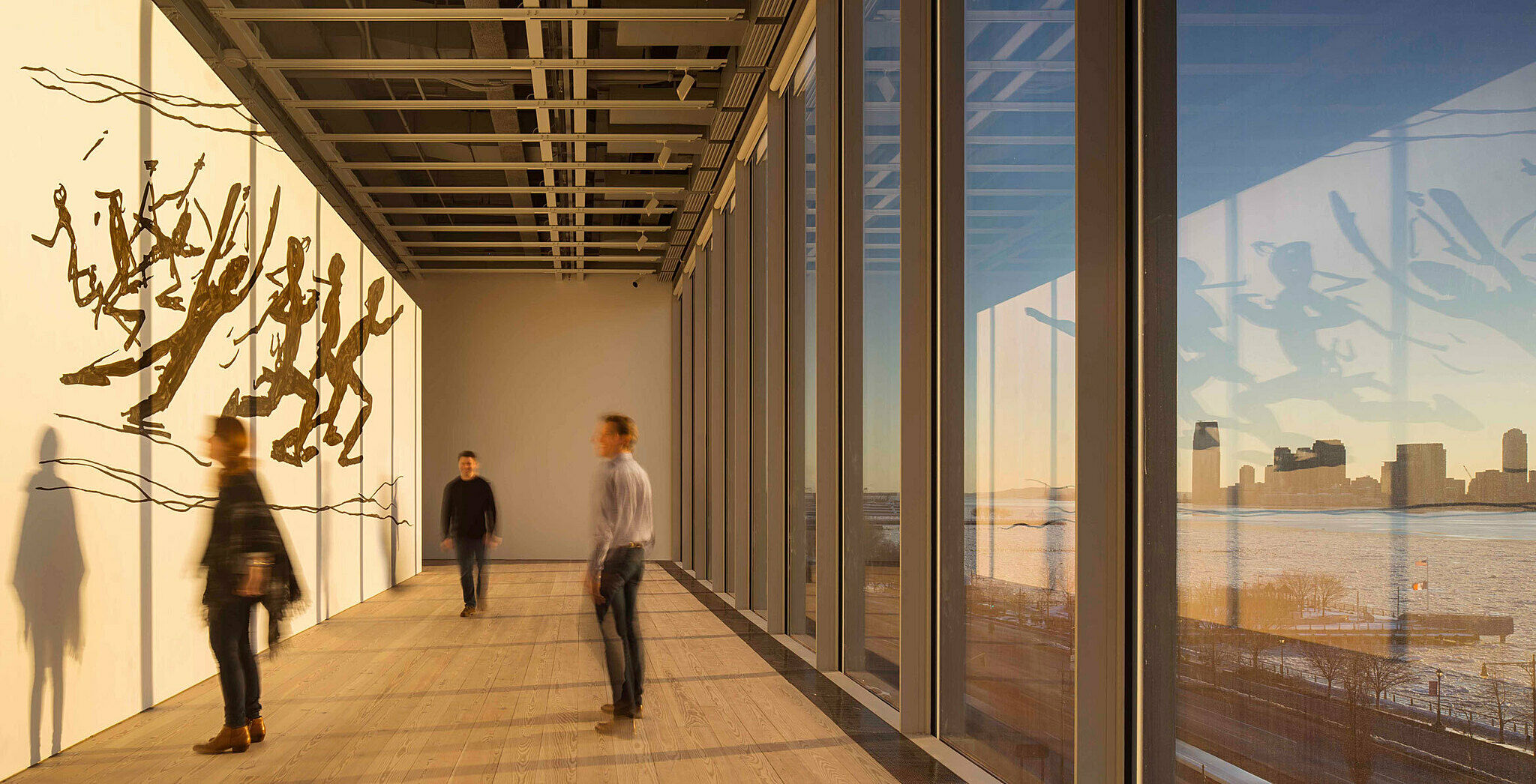
America Is Hard to See
May 1–Sept 27, 2015
-
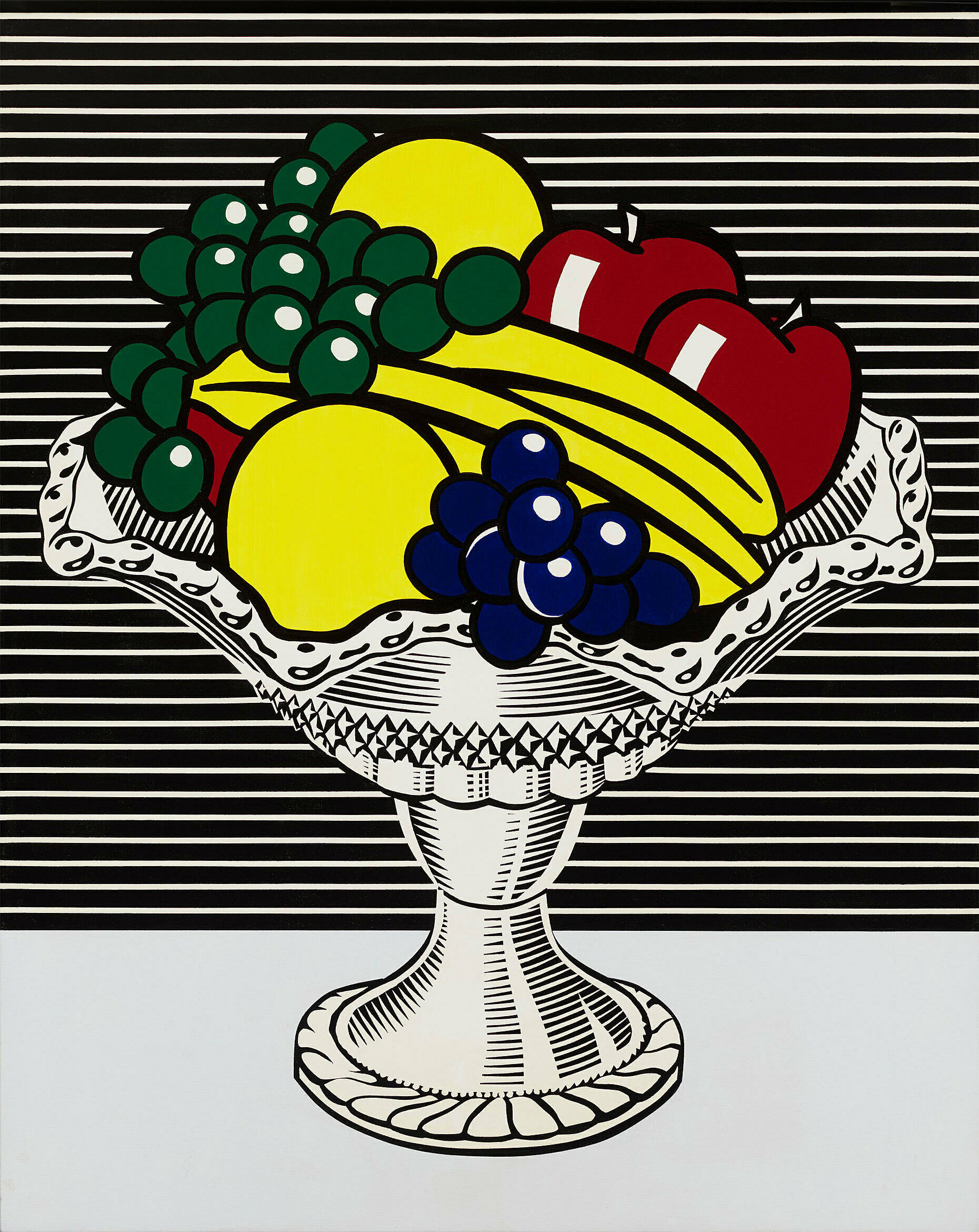
American Legends: From Calder to O’Keeffe
Dec 22, 2012–June 29, 2014
-
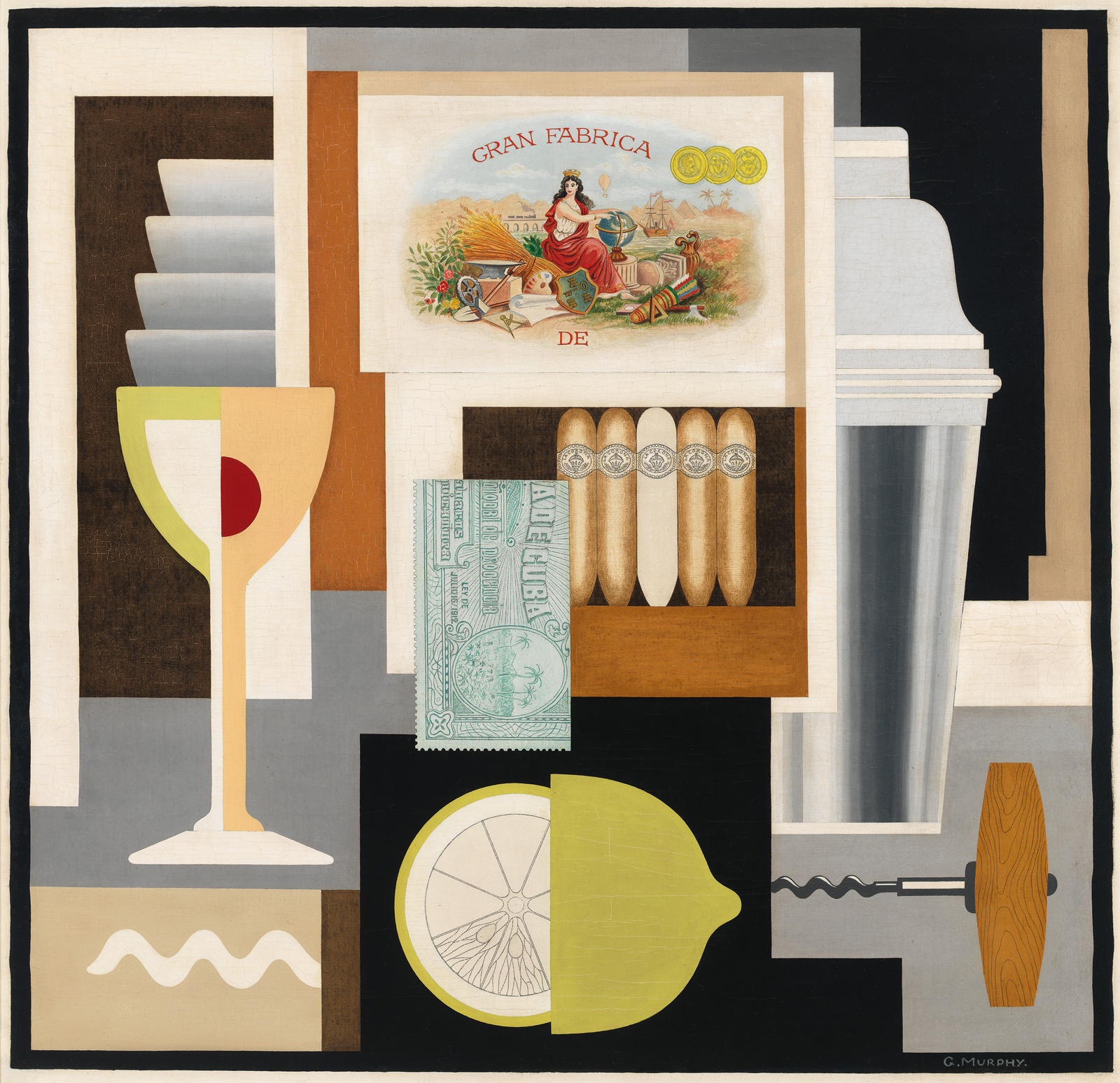
Highlights from the Permanent Collection: From Hopper to Mid-Century
Feb 25, 2000–May 20, 2006
Installation photography
-
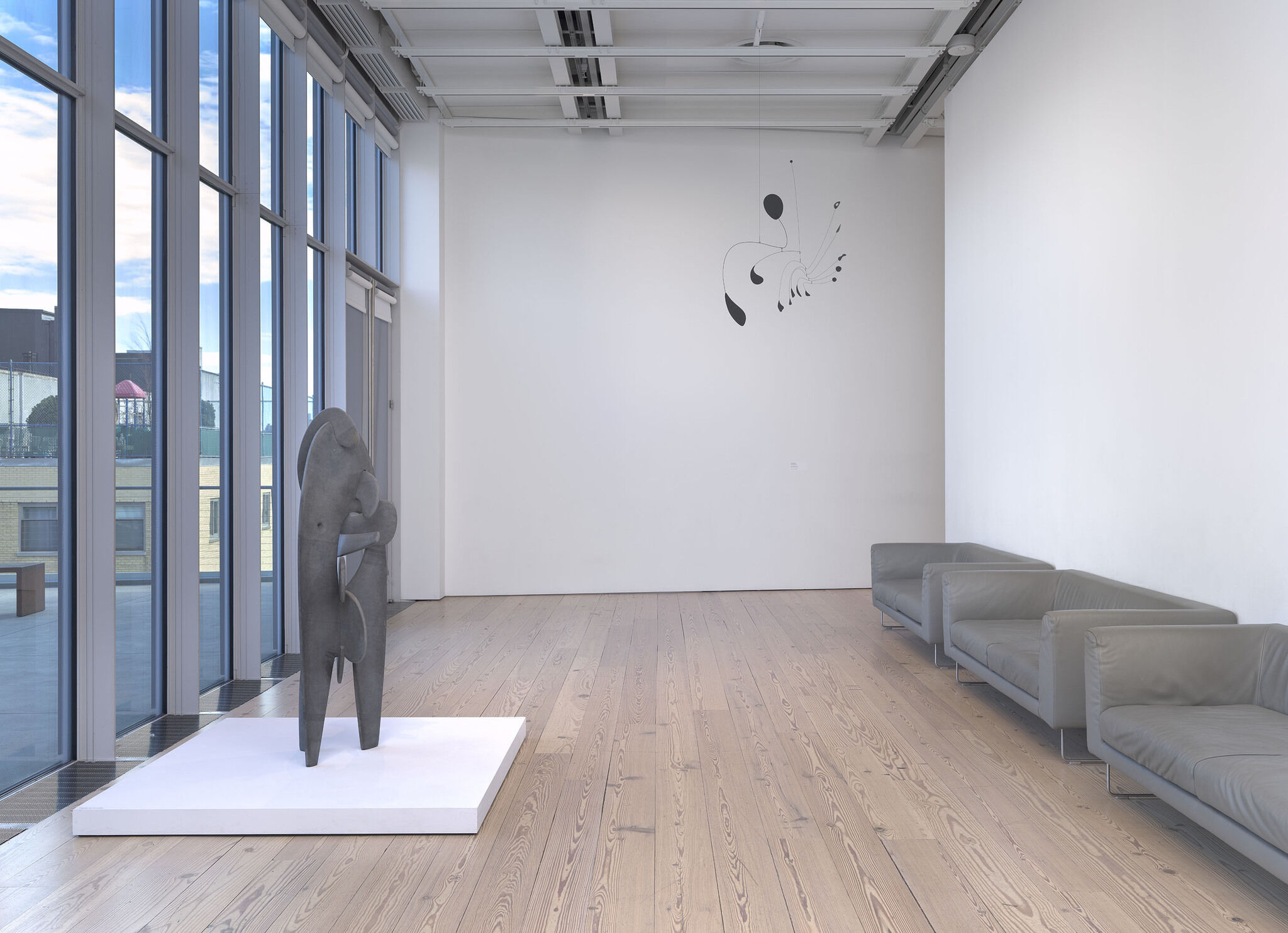

Installation view of Where We Are: Selections from the Whitney’s Collection, 1900–1960 (Whitney Museum of American Art, New York, April 28, 2017–June 2, 2019). From left to right: Isamu Noguchi, Humpty Dumpty, 1946; Alexander Calder, Hanging Spider, c. 1940. Photograph by Ron Amstutz
From the exhibition Where We Are: Selections from the Whitney’s Collection, 1900–1960
-
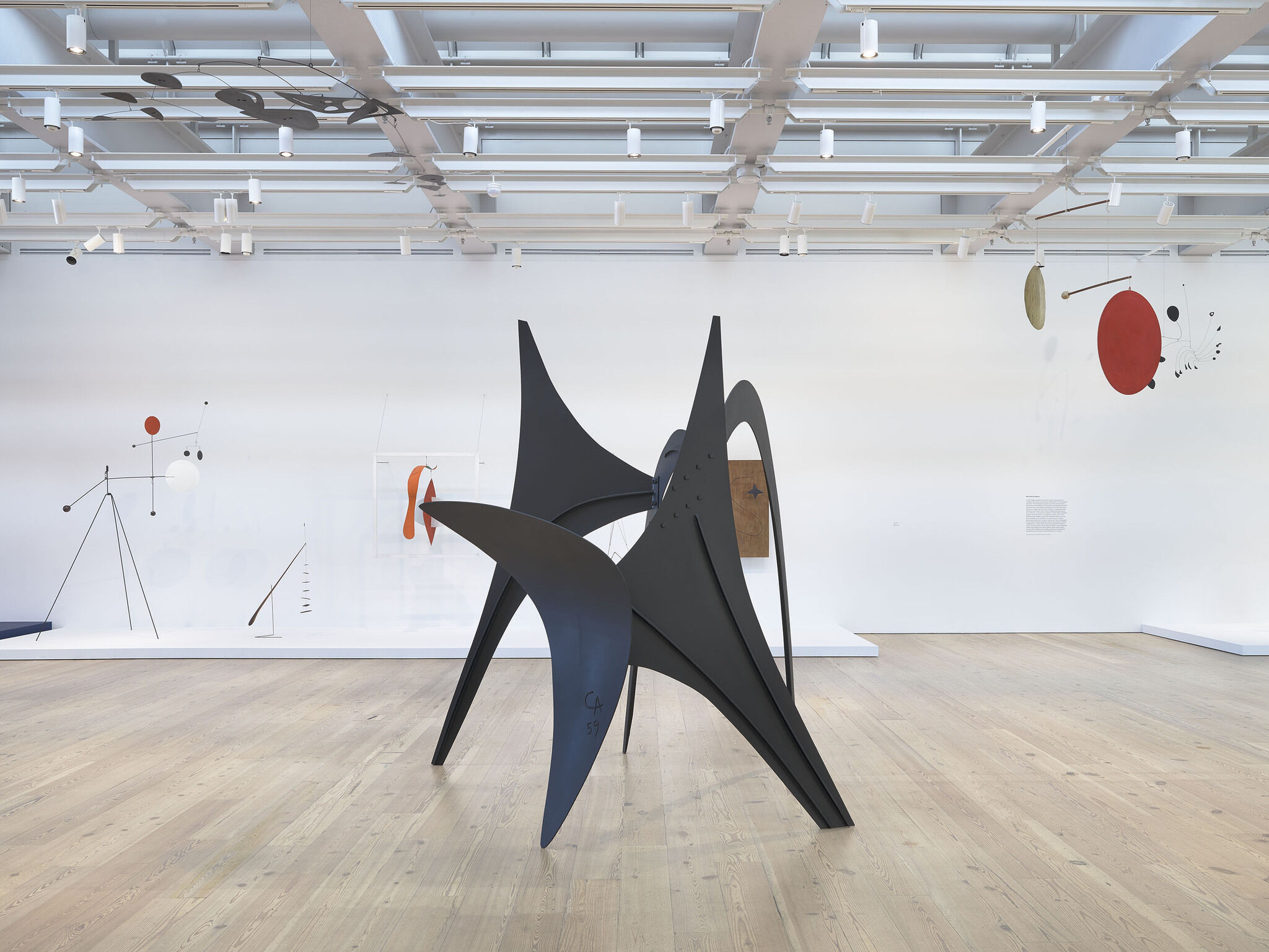

Installation view of Calder: Hypermobility (Whitney Museum of American Art, New York, June 9-October 23, 2017). Center, floor: Alexander Calder, The Arches, 1959, Whitney Museum of American Art, New York, gift of Howard and Jean Lipman 82.44a-e. Center, hanging: Alexander Calder, Black Lace, c. 1947, Calder Foundation, New York. From left to right, back: Alexander Calder, Red, White, Black and Brass, 1934, Calder Foundation, New York, promised gift of Alexander S. C. Rower; Alexander Calder, Untitled, 1942, Calder Foundation, New York; Alexander Calder, Snake and the Cross, 1936, Calder Foundation, New York; Alexander Calder, S and Star, 1941, Calder Foundation, New York; Alexander Calder, Red Disc and Gong, 1940, Calder Foundation, New York, promised gift of Holton Rower; Alexander Calder, Hanging Spider, c. 1940, Whitney Museum of American Art, New York, Mrs. John B. Putnam Bequest 84.41 ©2017 Calder Foundation, New York/ Artists Rights Society (ARS), New York, N.Y. Photograph Ron Amstutz
From the exhibition Calder: Hypermobility
-
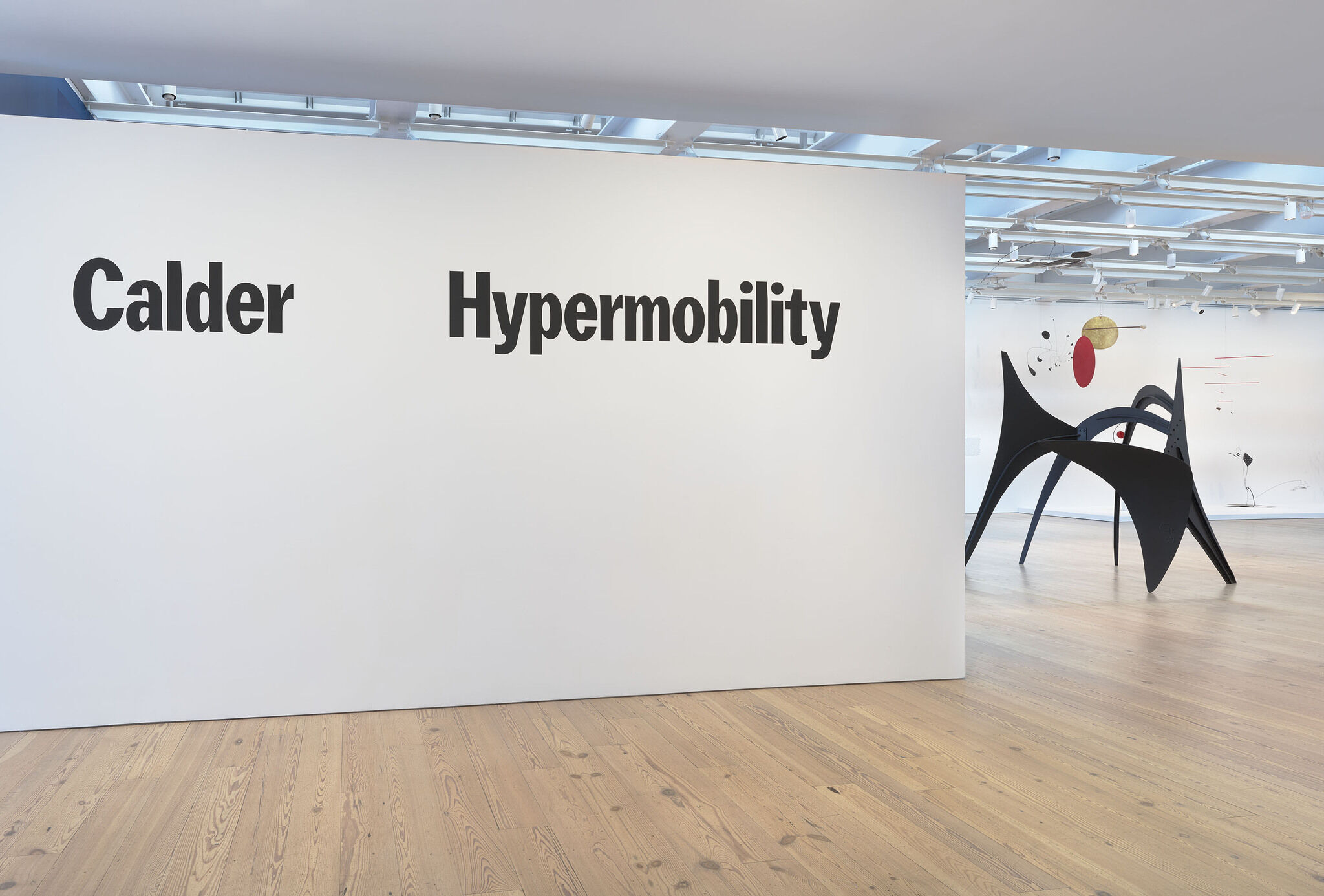

Installation view of Calder: Hypermobility (Whitney Museum of American Art, New York, June 9-October 23, 2017). From front to back, right to left: Alexander Calder, The Arches, 1959, Whitney Museum of American Art, New York, gift of Howard and Jean Lipman 82.44a-e; Alexander Calder, Black Lace, c. 1947, Calder Foundation, New York; Alexander Calder, Red Disc and Gong, 1940, Calder Foundation, New York, promised gift of Holton Rower; Alexander Calder, Hanging Spider, c. 1940, Whitney Museum of American Art, New York, Mrs. John B. Putnam Bequest 84.41; Alexander Calder, Red Sticks, c. 1943, Calder Foundation, New York; Alexander Calder, Half-circle, Quarter-circle, and Sphere, 1932, Whitney Museum of American Art, New York, purchase with funds from the Howard and Jean Lipman Foundation, Inc. 69.258; Alexander Calder, The Water Lily, c. 1945, Philadelphia Museum of Art, gift of Frances and Bayard Storey in memory of Anne d’Harnoncourt, 2013 ©2017 Calder Foundation, New York/ Artists Rights Society (ARS), New York, N.Y. Photograph Ron Amstutz
From the exhibition Calder: Hypermobility
-
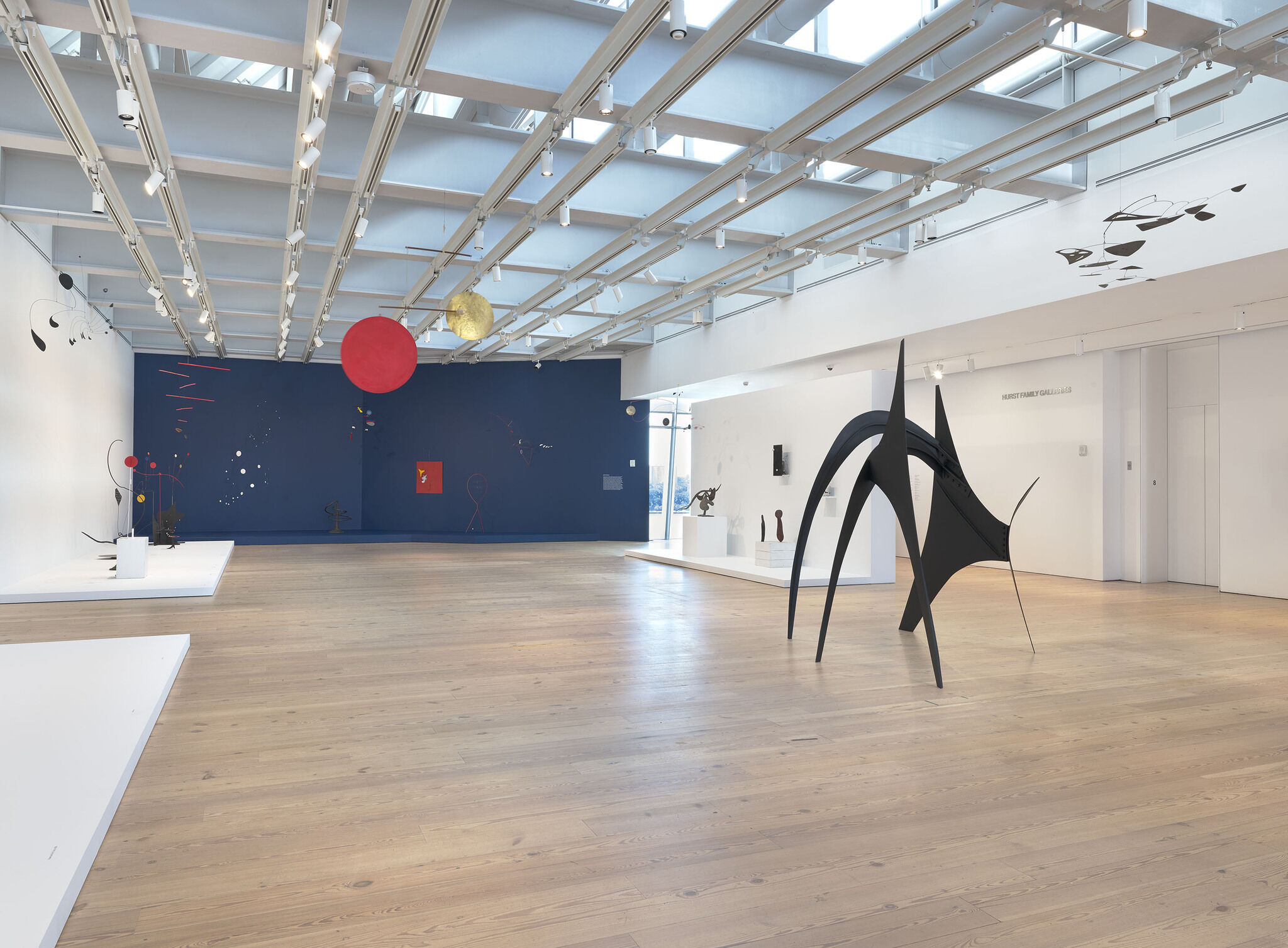

Installation view of Calder: Hypermobility (Whitney Museum of American Art, New York, June 9-October 23, 2017). Clockwise beginning in top right corner: Alexander Calder, Black Lace, c. 1947, Calder Foundation, New York; Alexander Calder, The Arches, 1959, Calder Foundation, New York; Alexander Calder, Red Disc and Gong, 1940, Calder Foundation, New York, promised gift of Holton Rower; Alexander Calder, Hanging Spider, c. 1940, Whitney Museum of American Art, New York, Mrs. John B. Putnam Bequest 84.41; Alexander Calder, Half-circle, Quarter-circle, and Sphere, 1932, Whitney Museum of American Art, New York, purchase with funds from the Howard and Jean Lipman Foundation, Inc. 69.258; Alexander Calder, The Water Lily, c. 1945, Philadelphia Museum of Art, gift of Frances and Bayard Storey in memory of Anne d’Harnoncourt, 2013; Alexander Calder, Untitled, 1947, Calder Foundation, New York; Alexander Calder, Black Tulip, c. 1942, Collection of Irma and Norman Braman; Alexander Calder, Red Sticks, c. 1943, Calder Foundation, New York; Alexander Calder, Blizzard (Roxbury Flurry), 1946, Whitney Museum of American Art, New York, gift of Louisa Calder 77.85a-d; Alexander Calder, The Helices, 1944, Calder Foundation, New York; Alexander Calder, Sea Scape, 1947, Whitney Museum of American Art, New York, purchase with funds from the Howard and Jean Lipman Foundation, Inc. 72.121; Alexander Calder, Red Panel, 1936, Calder Foundation, New York; Alexander Calder, Hour Glass, 1941, The Lipman Family Foundation, long term loan to the Whitney Museum of American Art, New York; Alexander Calder, Bifurcated Tower, 1950, Whitney Museum of American Art, New York, purchase with funds from the Howard and Jean Lipman Foundation, Inc. and exchange 73.31a-f; Alexander Calder, Triple Gong, c. 1948, Calder Foundation, New York, promised gift of Holton Rower; Alexander Calder, Octopus, 1944, Harvard Art Museums/Fogg Museum, Cambridge, Massachusetts, gift of Lois Orswell; Alexander Calder, Two Spheres, 1931, Calder Foundation, New York, promised gift of Holton Rower; Alexander Calder, Machine motorisée, 1933, Calder Foundation, New York, Alexander Calder, Red Panel, c. 1934, Calder Foundation, New York, promised gift of Alexander S. C. Rower ©2017 Calder Foundation, New York/ Artists Rights Society (ARS), New York, N.Y. Photograph Ron Amstutz
From the exhibition Calder: Hypermobility
-
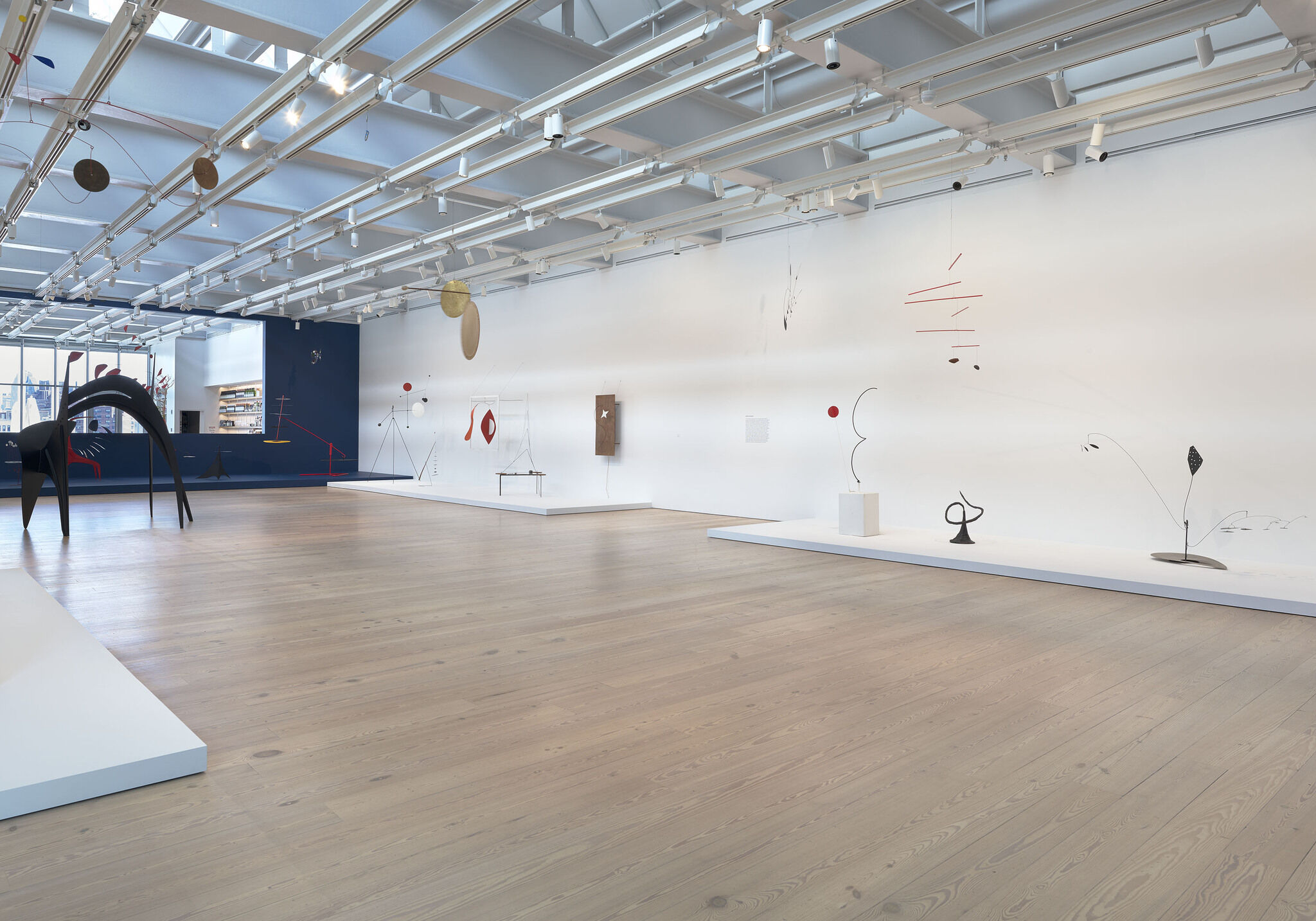

Installation view of Calder: Hypermobility (Whitney Museum of American Art, New York, June 9-October 23, 2017). Clockwise from top left corner: Alexander Calder, Triple Gong, c. 1948, Calder Foundation, New York, promised gift pf Holton Rower; Alexander Calder, The Arches, 1959, Whitney Museum of American Art, New York, gift of Howard and Jean Lipman 82.44a-e; Alexander Calder, Aspen, 1948, Calder Foundation, New York; Alexander Calder, Aluminum Leaves, Red Post, 1941, The Lipman Family foundation, long-term loan to the Whitney Museum of American Art, New York; Alexander Calder, Big Red, 1959, Whitney Museum of American Art, New York, purchase with funds from the Friends of the Whitney Museum of American Art and by exchange 61.46a-c; Alexander Calder, Parasite, 1947, Calder Foundation, New York, promised gift of Holton Rower; Alexander Calder, Smoke Rings, 1968, Nahmad Collection; Alexander Calder, Fish, 1944, Whitney Museum of American Art, New York, bequest of Richard S. Zeisler 2007.82; Alexander Calder, Red White Black and Brass, 1934, Calder Foundation, New York, promised gift of Alexander S.C. Rower; Alexander Calder, Untitled, 1942, Calder Foundation, New York; Alexander Calder, Snake and the Cross, 1936, Calder Foundation, New York; Alexander Calder, Untitled, 1938, Calder Foundation, New York, promised gift of Alexander S. C. Rower; Alexander Calder, S and Star, 1941, Calder Foundation, New York; Alexander Calder, Hanging Spider, c. 1940, Whitney Museum of American Art, New York, Mrs. John B. Putnam Bequest 84.41; Alexander Calder, Half-circle, Quart-circle, and Sphere, 1932, Whitney Museum of American Art, New York, purchase with funds from the Howard and Jean Lipman Foundation, Inc. 70.3a-b; Alexander Calder, Red Sticks, c. 1943, Calder Foundation, New York; Alexander Calder, Whip Snake (Snake on the Post), 1944, Whitney Museum of American Art, New York, purchase with funds from the Howard and Jean Lipman Foundation, Inc. 70.3a-b; Alexander Calder, The Water Lily, c. 1945, Philadelphia Museum of Art, gift of Frances and Bayard Storey in memory of Anne d’Harnoncourt, 2013 ©2017 Calder Foundation, New York/ Artists Rights Society (ARS), New York, N.Y. Photograph Ron Amstutz
From the exhibition Calder: Hypermobility
-
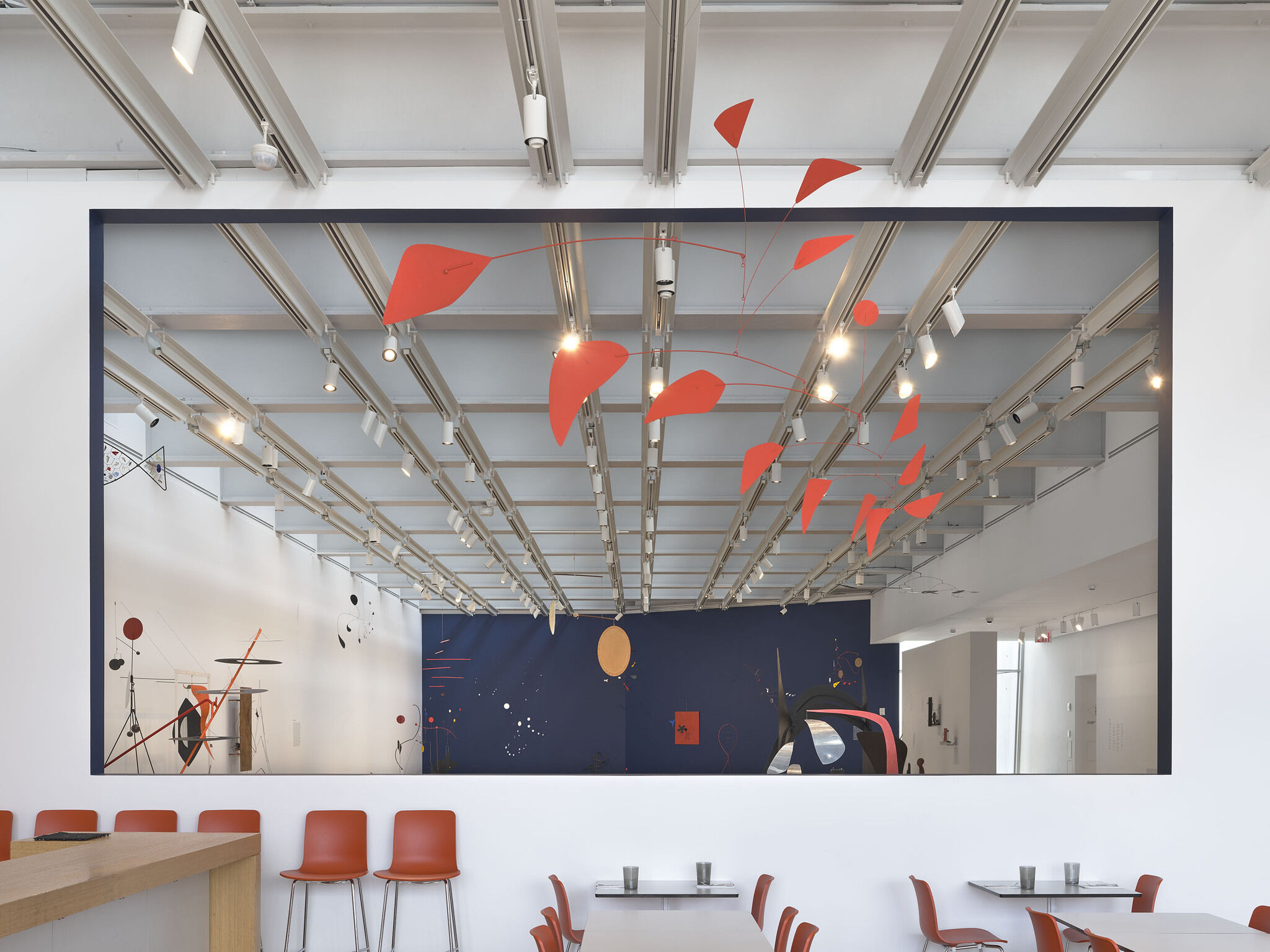

Installation view of Calder: Hypermobility (Whitney Museum of American Art, New York, June 9-October 23, 2017). Clockwise beginning top center: Alexander Calder, Big Red, 1959, Whitney Museum of American Art, New York, purchase with funds from the Friends of the Whitney Museum of American Art and by exchange 61.46a-c; Alexander Calder, Black Lace, c. 1947, Calder Foundation, New York; Alexander Calder, Triple Gong, c. 1948, Calder Foundation, New York, promised gift of Holton Rower; Alexander Calder, Two Spheres, 1931, Calder Foundation, New York, promised gift of Holton Rower; Alexander Calder, Red Panel, c. 1934, Calder Foundation, promised gift of Alexander S. C. Rower; Alexander Calder, Machine motorisée, 1933, Calder Foundation, New York; Alexander Calder, Aluminum Leaves, Red Post, 1941, The Lipman Family Foundation, long-term loan to the Whitney Museum of American Art, New York, T.1996.7; Alexander Calder, The Arches, 1959, Whitney Museum of American Art, New York, gift of Howard and Jean Lipman 82.44a-e; Alexander Calder, Bifurcated Tower, 1950, Whitney Museum of American Art, New York, purchase with funds from the Howard and Jean Lipman Foundation, Inc. and exchange 73.31a-f; Alexander Calder, Hour Glass, 1941, The Lipman Family Foundation, long-term loan to the Whitney Museum of American Art, New York, T.1996.8; Alexander Calder, Red Disc and Gong, 1940, Calder Foundation, New York, promised gift of Holton Rower; Alexander Calder, Sea Scape, 1947, Whitney Museum of American Art, New York, purchase with funds from the Howard and Jean Lipman Foundation, Inc. 72.121; Alexander Calder, The Helices, 1944, Calder Foundation, New York; Alexander Calder, Blizzard (Roxbury Flurry), 1946, Whitney Museum of American Art, New York, gift of Louisa Calder; Alexander Calder, Red Sticks, c. 1943, Calder Foundation, New York; Alexander Calder, Black Tulip, c. 1942, Collection of Irma and Norman Braman; Alexander Calder, The Water Lily, c. 1945, Philadelphia Museum of Art, gift of Frances and Bayard Storey in memory of Anne d’Harnoncourt, 2013; Alexander Calder, Half-circle, Quarter-circle, and Sphere, 1932, Whitney Museum of American Art, New York, purchase with funds from the Howard and Jeam Lipman Foundation, Inc. 69.258; Alexander Calder, Hanging Spider, c. 1940, Whitney Museum of American Art, New York, Mrs. John B. Putnam Bequest 84.41; Alexander Calder, S and Star, 1941, Calder Foundation, New York; Alexander Calder, Snake and the Cross, 1936, Calder Foundation, New York; Alexander Calder, Smoke Rings, 1968, Nahmad Collection; Alexander Calder, Red, White, Black and Brass, 1934, Calder Foundation, New York, promised gift of Alexander S.C. Rower; Alexander Calder, Fish, 1944, Whitney Museum of American Art, New York, bequest of Richard S. Zeisler 2007.82 ©2017 Calder Foundation, New York/ Artists Rights Society (ARS), New York, N.Y. Photograph Ron Amstutz
From the exhibition Calder: Hypermobility
-
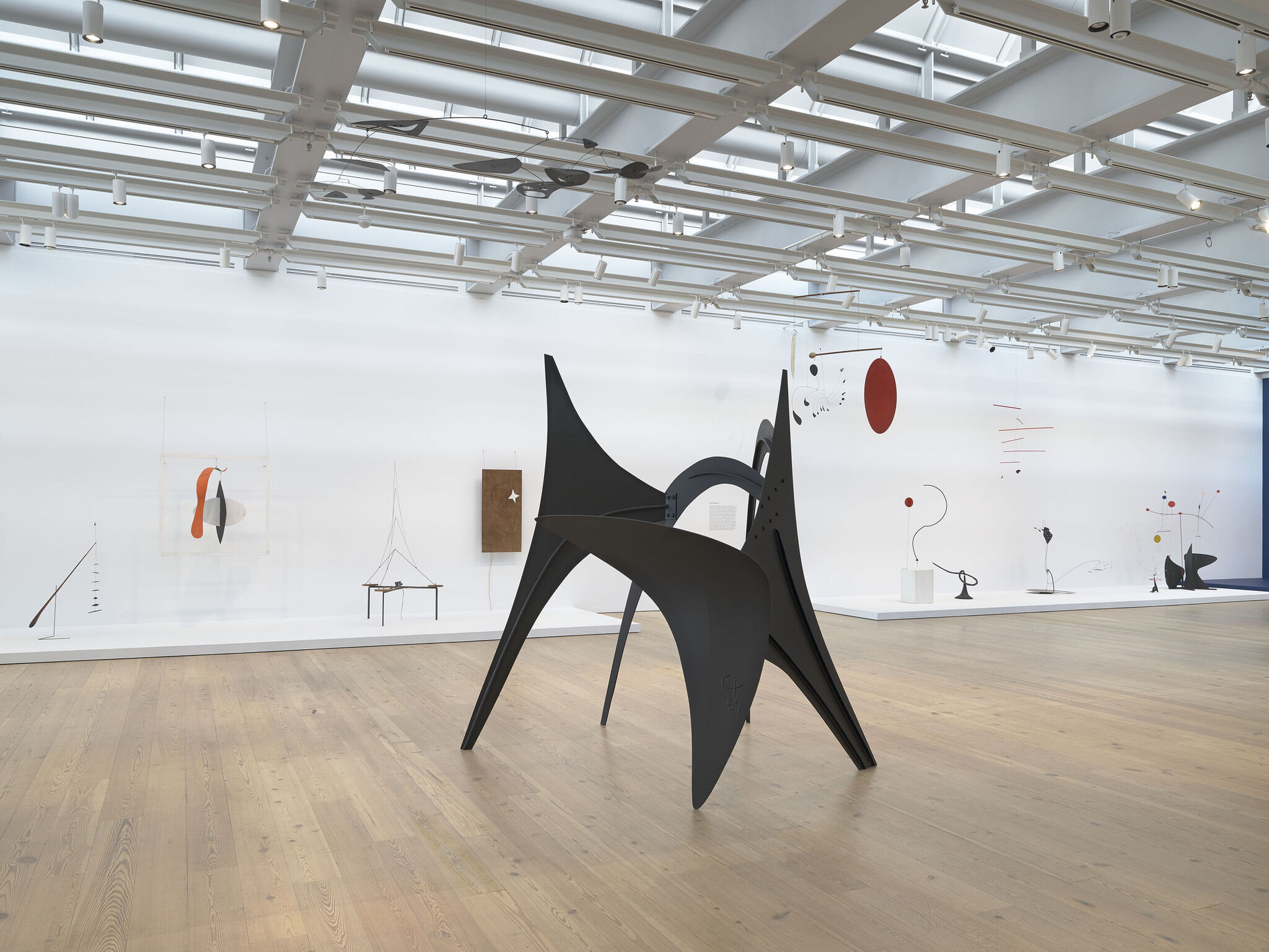

Installation view of Calder: Hypermobility (Whitney Museum of American Art, New York, June 9-October 23, 2017). From left to right: Alexander Calder, Untitled, 1942, Calder Foundation, New York ; Alexander Calder, Snake and the Cross, 1936, Calder Foundation, New York; Alexander Calder, Untitled, 1938, Calder Foundation, New York, promised gift of Alexander S. C. Rower; Alexander Calder, S and Star, 1941, Calder Foundation, New York; Alexander Calder, The Arches, 1959, Whitney Museum of American Art, New York, gift of Howard and Jean Lipman 82.44a-e; Alexander Calder, Hanging Spider, c. 1940, Whitney Museum of American Art, New York, Mrs. John B. Putnam Bequest 84.41; Alexander Calder, Red Disc and Gong, 1940, Calder Foundation, New York, promised gift of Holton Rower; Alexander Calder, Half-circle, Quarter-circle, and Sphere, 1932, Whitney Museum of American Art, New York, purchase with funds from the Howard and Jean Lipman Foundation, Inc. 69.258; Alexander Calder, Whip Snake (Snake on the Post), 1944, Whitney Museum of American Art, New York, purchase with funds from the Howard and Jean Lipman Foundation, Inc. 70.3a-b; Alexander Calder, Red Sticks, c. 1943, Calder Foundation, New York; Alexander Calder, The Water Lily, c. 1945, Philadelphia Museum of Art, gift of Frances and Bayard Storey in memory of Anne d’Harnoncourt, 2013; Alexander Calder, Untitled, 1947, Calder Foundation, New York; Alexander Calder, Black Tulip, c. 1942, Collection of Irma and Norman Braman. Hanging above center: Alexander Calder, Black Lace, c. 1947, Calder Foundation, New York ©2017 Calder Foundation, New York/ Artists Rights Society (ARS), New York, N.Y. Photograph Ron Amstutz
From the exhibition Calder: Hypermobility
-
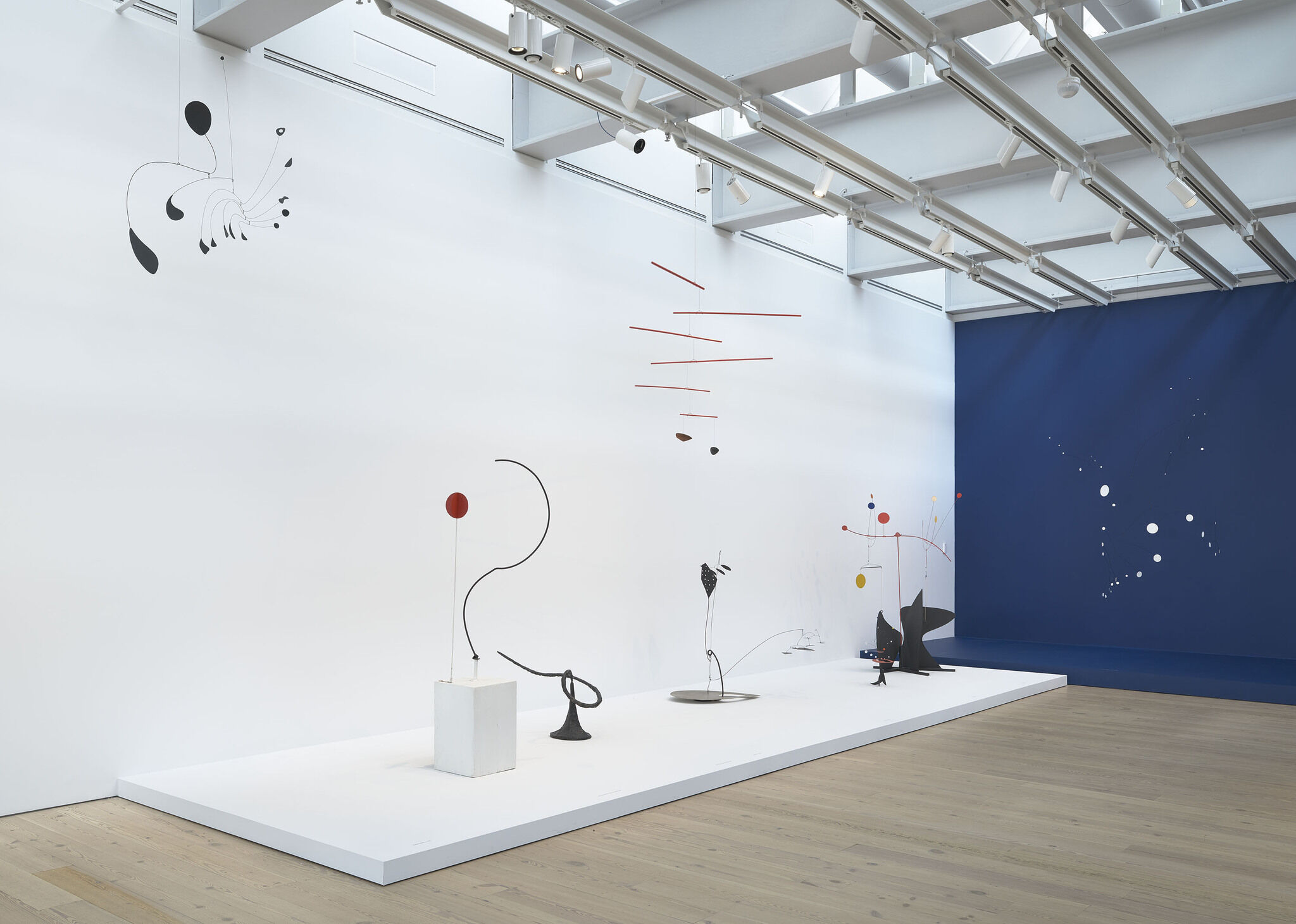

Installation view of Calder: Hypermobility (Whitney Museum of American Art, New York, June 9-October 23, 2017). From left to right: Alexander Calder, Hanging Spider, c. 1940, Whitney Museum of American Art, New York, Mrs. John B. Putnam Bequest 84.41; Alexander Calder, Half-circle, Quarter-circle, and Sphere, 1932, Whitney Museum of American Art, New York, purchase with funds from the Howard and Jean Lipman Foundation, Inc. 69.258; Alexander Calder, Whip Snake (Snake on the Post), 1944, Whitney Museum of American Art, New York, purchase with funds from the Howard and Jean Lipman Foundation, Inc. 70.3a-b; Alexander Calder, Red Sticks, c. 1943, Calder Foundation, New York; Alexander Calder, The Water Lily, c. 1945, Philadelphia Museum of Art, gift of Frances and Bayard Storey in memory of Anne d’Harnoncourt, 2013; Alexander Calder, Untitled, 1947, Calder Foundation, New York; Alexander Calder, Black Tulip, c. 1942, Collection of Irma and Norman Braman; Alexander Calder, Blizzard (Roxbury Flurry), 1946, Whitney Museum of American Art, New York, gift of Louisa Calder 77.85a-d ©2017 Calder Foundation, New York/ Artists Rights Society (ARS), New York, N.Y. Photograph Ron Amstutz
From the exhibition Calder: Hypermobility
-
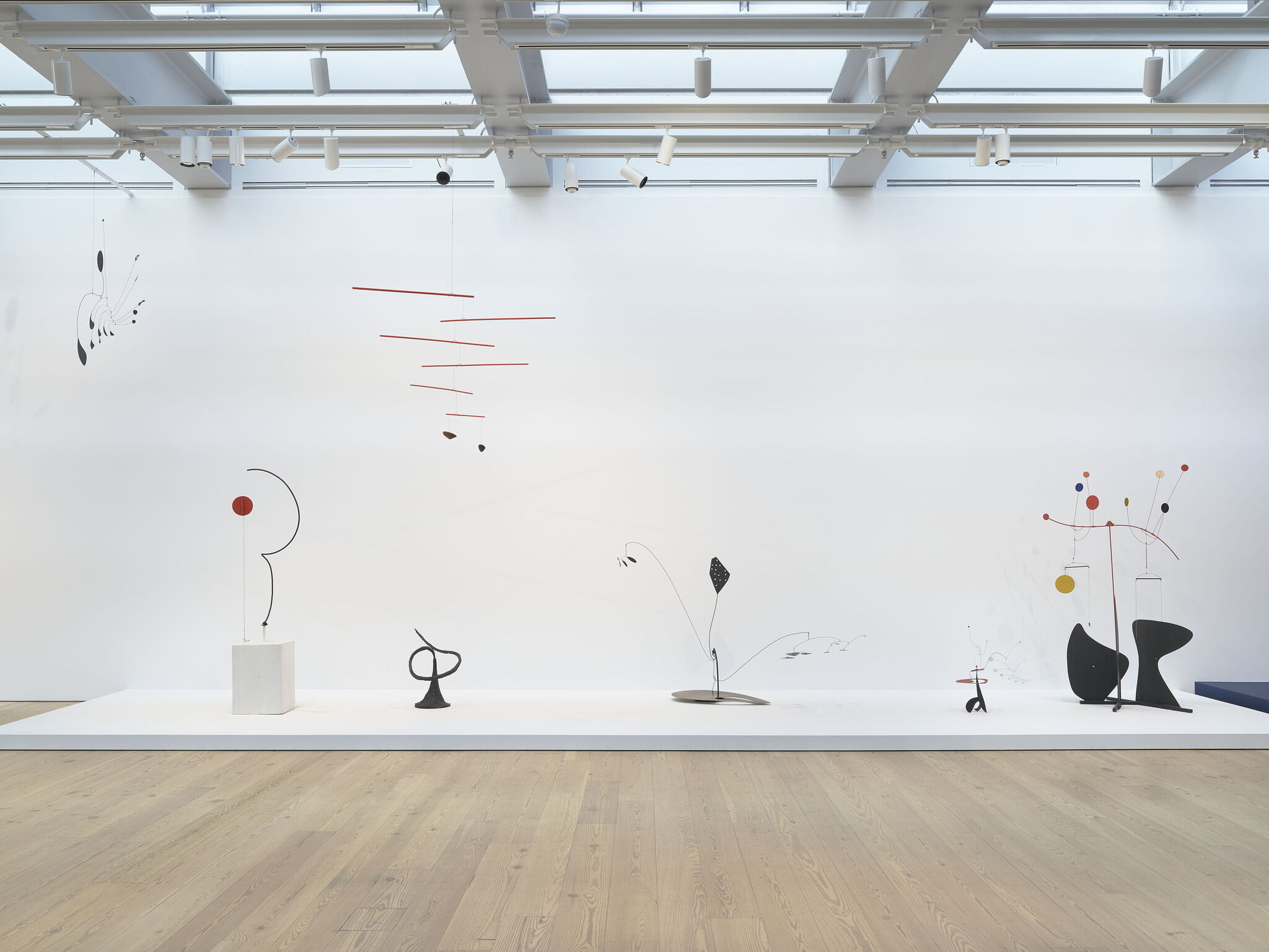

Installation view of Calder: Hypermobility (Whitney Museum of American Art, New York, June 9-October 23, 2017). Hanging from left to right: Alexander Calder, Hanging Spider, c. 1940, Whitney Museum of American Art, New York, Mrs. John B. Putnam Bequest 84.41; Alexander Calder, Red Sticks, c. 1943, Calder Foundation, New York. Standing from left to right: Alexander Calder, Half-circle, Quarter-circle, and Sphere, 1932, Whitney Museum of American Art, New York, purchase with funds from the Howard and Jean Lipman Foundation, Inc. 69.258; Alexander Calder, Whip Snake (Snake on the Post), 1944, Whitney Museum of American Art, New York, purchase with funds from the Howard and Jean Lipman Foundation, Inc. 70.3a-b; Alexander Calder, The Water Lily, c. 1945, Philadelphia Museum of Art, gift of Frances and Bayard Storey in memory of Anne d’Harnoncourt, 2013; Alexander Calder, Untitled, 1947, Calder Foundation, New York; Alexander Calder, Black Tulip, c. 1942, Collection of Irma and Norman Braman ©2017 Calder Foundation, New York/ Artists Rights Society (ARS), New York, N.Y. Photograph Ron Amstutz
From the exhibition Calder: Hypermobility
-
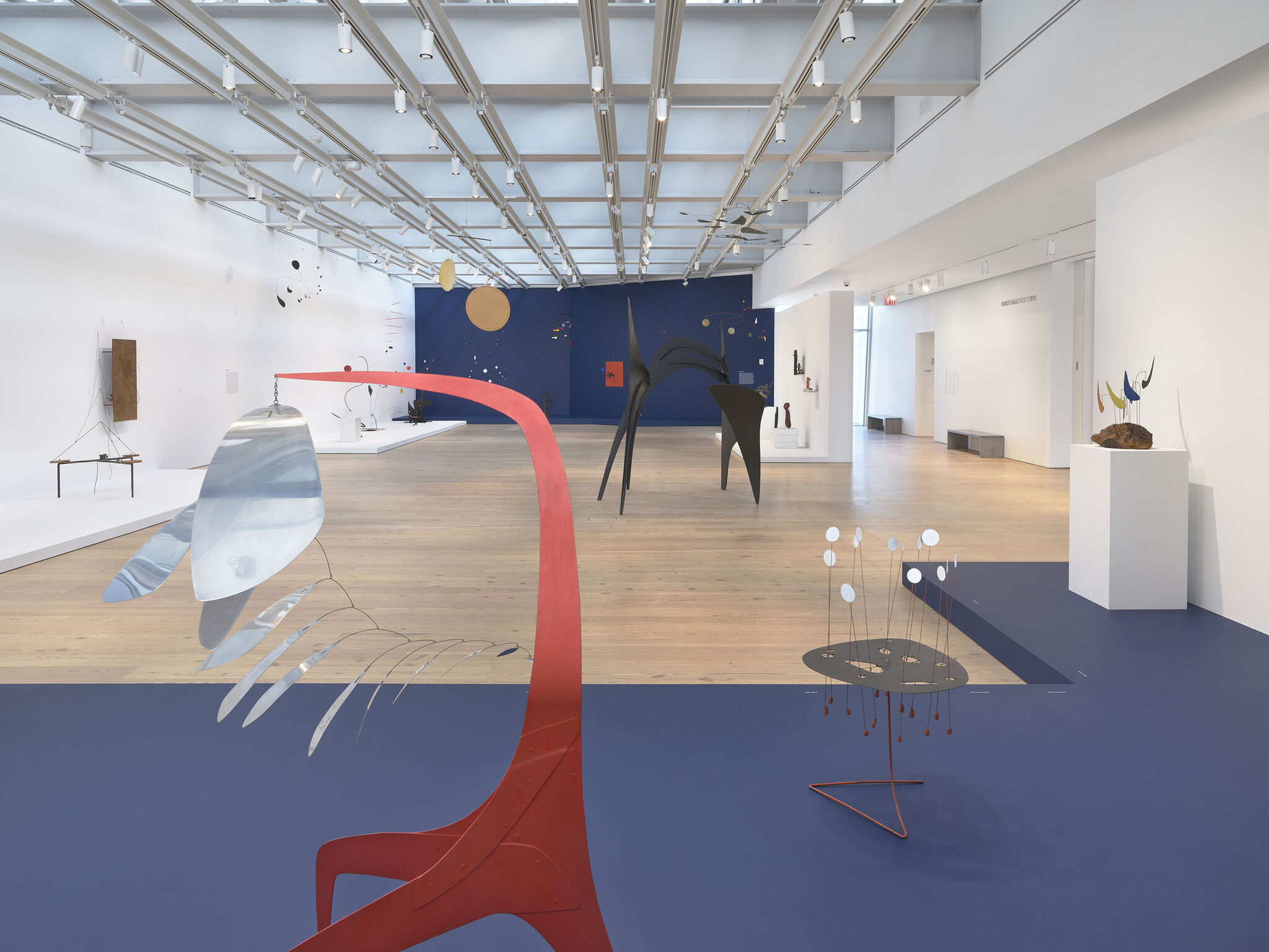

Installation view of Calder: Hypermobility (Whitney Museum of American Art, New York, June 9-October 23, 2017). Clockwise beginning from bottom left: Alexander Calder, Aluminum Leaves, Red Post, 1941, The Lipman Family Foundation, long-term loan to the Whitney Museum of American Art, New York, T.1996.7; Alexander Calder, Untitled, 1938, Calder Foundation, New York, promised gift of Alexander S. C. Rower; Alexander Calder, S and Star, 1941, Calder Foundation, New York; Alexander Calder, Hanging Spider, c. 1940, Whitney Museum of American Art, New York, Mrs. John B. Putnam Bequest 84.41; Alexander Calder, Half-circle, Quarter-circle, and Sphere, 1932, Whitney Museum of American Art, New York, purchase with funds from the Howard and Jean Lipman Foundation, Inc. 69.258; Alexander Calder, Whip Snake (Snake on the Post), 1944, Whitney Museum of American Art, New York, purchase with funds from the Howard and Jean Lipman Foundation, Inc. 70.3a-b; Alexander Calder, The Water Lily, c. 1945, Philadelphia Museum of Art, gift of Frances and Bayard Storey in memory of Anne d’Harnoncourt, 2013; Alexander Calder, Red Sticks, c. 1943, Calder Foundation, New York; Alexander Calder, Untitled, 1947, Calder Foundation, New York; Alexander Calder, Black Tulip, c. 1942, Collection of Irma and Norman Braman; Alexander Calder, Red Disc and Gong, 1940, Calder Foundation, New York, promised gift of Holton Rower; Alexander Calder, Blizzard (Roxbury Flurry), 1946, Whitney Museum of American Art, New York, gift of Louisa Calder 77.85a-d; Alexander Calder, The Helices, 1944, Calder Foundation, New York; Alexander Calder, Sea Scape, 1947, Whitney Museum of American Art, New York, purchase with funds from the Howard and Jean Lipman Foundation, Inc. 72.121; Alexander Calder, Red Panel, 1936, Calder Foundation, New York; Alexander Calder, Bifurcated Tower, 1950, Whitney Museum of American Art, New York, purchase with funds from the Howard and Jean Lipman Foundation, Inc. and exchange 73.31a-f; Alexander Calder, Triple Gong, c. 1948, Calder Foundation, New York, promised gift of Holton Rower; Alexander Calder, Two Spheres, 1931, Calder Foundation, New York, promised gift of Holton Rower; Alexander Calder, Red Panel, c. 1934, Calder Foundation, New York, promised gift of Alexander S. C. Rower; Alexander Calder, Octopus, 1944, Harvard Art Museums/Fogg Museum, Cambridge Massachusetts, gift of Lois Orswell; Alexander Calder, Machine motorisée, 1933, Calder Foundation, New York; Alexander Calder, The Arches, 1959, Whitney Museum of American Art, New York, gift of Howard and Jean Lipman 82.44a-e; Alexander Calder, Myrtle Burl, 1941, Calder Foundation, New York, Mary Calder Rower Bequest, 2011; Alexander Calder, Aspen, 1948, Calder Foundation, New York ©2017 Calder Foundation, New York/ Artists Rights Society (ARS), New York, N.Y. Photograph Ron Amstutz
From the exhibition Calder: Hypermobility
-
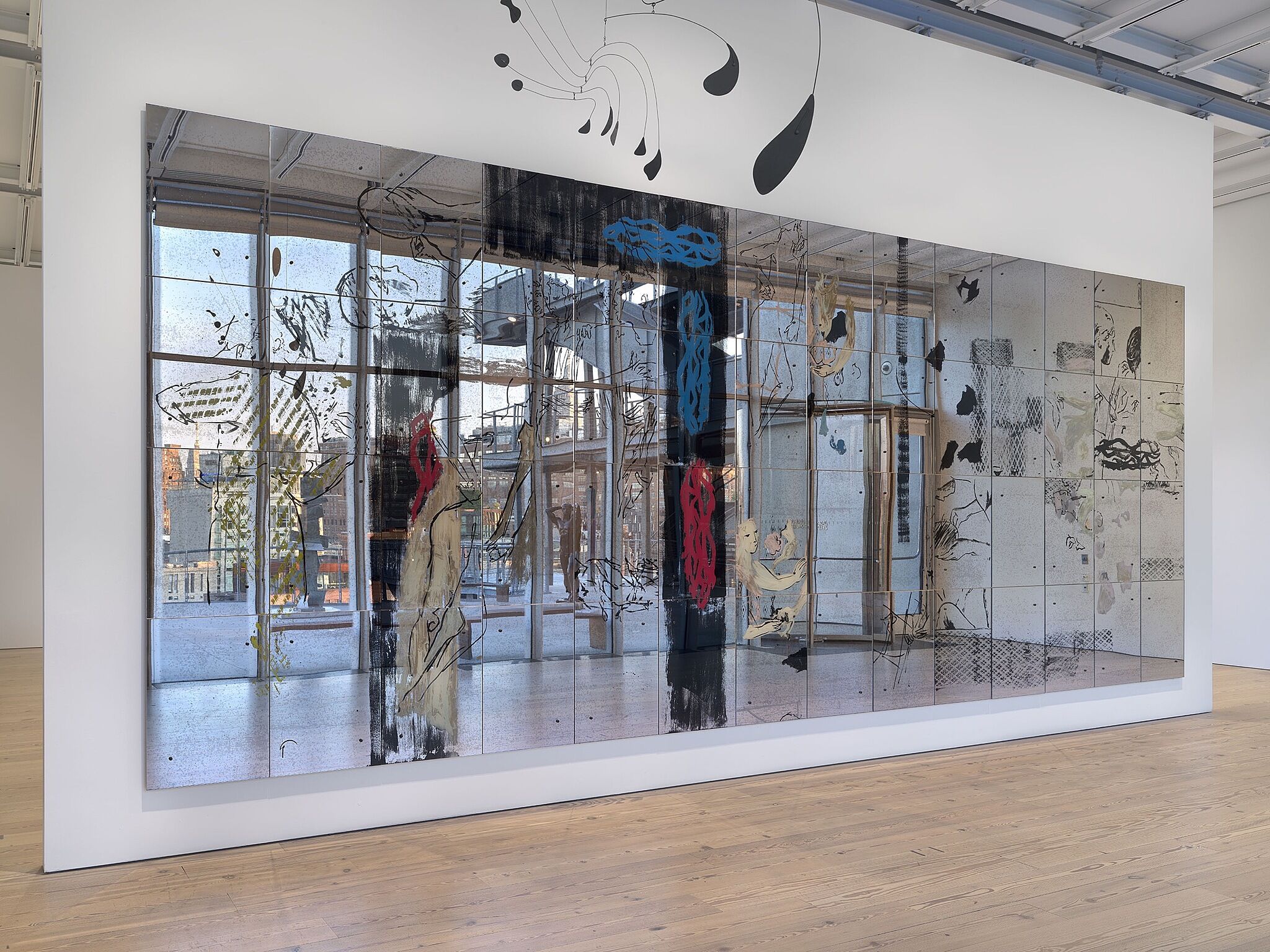

Installation view of The Whitney’s Collection: Selections from 1900 to 1965 (Whitney Museum of American Art, New York, June 28, 2019- ). Nick Mauss, Images in Mind, 2018. Hanging: Alexander Calder, Hanging Spider, c. 1940. Photograph by Ron Amstutz
From the exhibition The Whitney’s Collection: Selections from 1900 to 1965

